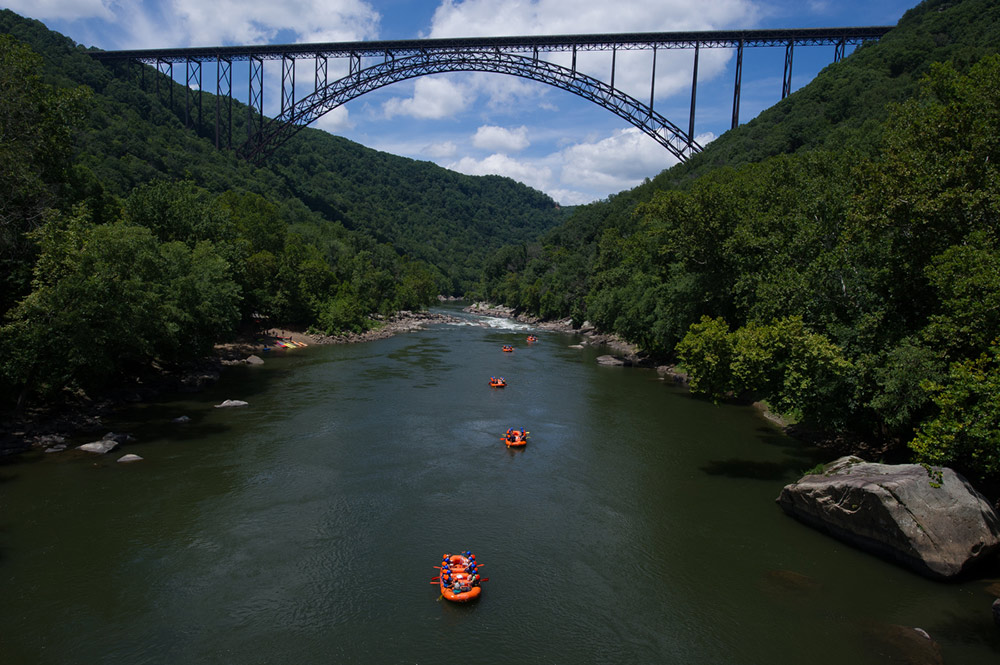美国的西弗吉尼亚州曾经一度靠煤炭繁荣,但随着煤炭需求的下降,该州经济早已一蹶不振,近年来,它一直在与高失业率、贫困率和吸毒率作斗争。现在,以思科公司(Cisco)前总裁约翰·钱伯斯、知名投资人雷·莱恩、财捷集团(Intuit)前首席执行官布拉德·史密斯为代表的一些西弗吉尼亚籍企业家正在对家乡进行投资,希望将该州打造成一个科技和创新中心,让西弗吉尼亚州成为一个更有吸引力的工作、生活和创新之地。他们会成功吗?甚至他们能够让西弗吉尼亚州实现任何变化吗?要改变该州的形象,光有钱还不行,而是要真正让它的经济产生内生动力。不过你总是要从某个地方着手做起。如果西弗吉尼亚州可以成功振兴,那么任何地方也都应该能够做到。
人人都说,西弗吉尼亚有很多让人喜欢的地方,这里景色郁郁葱葱,生活成本低廉,这里的人也很友好。
我个人从未去过这个州。直到最近,我对西弗吉尼亚州最深的印象,还来自一部名叫《西弗吉尼亚白人纪事》(The Wild and Wonderful Whites of West Virginia)的纪录片,它记录了一个生活在阿巴拉契亚地区的亡命徒家族的故事。这部影片成功地塑造了人们对西弗吉尼亚州的农村人的刻板印象——贫穷、吸毒、违法乱纪。(他们还爱跳“山地舞”,它基本上就是一种狂乱版本的踢踏舞。)总之,这部片子虽然很好看,但在看完之后,你一点也不会觉得西弗吉尼亚这个地方很吸引人。
当然,所有地方都有可爱之处,这里也不例外。首先是美景,西弗吉尼亚州是美国的漂流胜地,也是开展其他户外活动的好地方。不过说起经济,情况就没有那么乐观了。西弗吉尼亚州曾经是一个靠煤炭发家的工业州,但它如今在就业率、专利注册量和创业公司集中度等多个指标上排名垫底。美国人口普查局(U.S. Census Bureau)的数据显示,该州只有180万人口,而且它也是美国最穷的州之一,平均家庭收入只有46711美元,远低于全美平均水平(68703美元)。另据美国国家药物滥用研究所(National Institute on Drug Abuse)统计,该州的阿片类物质滥用致死率也是全美最高的。
西弗吉尼亚大学户外经济发展合作部(Outdoor Economic Development Collaborative at West Virginia University)的助理副总裁格雷格·科里奥称:“我们在所有的好事里垫底,在所有的坏事里排在前面。”
为了改变该州的落后面貌。科里奥的部门不光想让人们来旅游,还想让人们长期住在这里。为了实现这个宏伟目标,该部门正在以西弗吉尼亚州的美景和户外活动为卖点,吸引广大在家办公者来此居住。(科里奥本身就是一位户外爱好者,他在大学时就发明了一种人造攀冰墙。)目前,美国的很多地区都在吸引科技工作者和创业者,特别是自新冠疫情爆发以来,居家办公成了一个被更多人接受的选择。科里奥认为,虽然西弗吉尼亚州面临着各种挑战,但它也拥有很多天然的优势。
他说:“西弗吉尼亚州的漂流和攀岩点,比科罗拉多州和犹他州加起来还要多。”(请注意,虽然这听起来很了不起,但他的话并未经过笔者核实。)

西弗吉尼亚州还有另一个“秘密武器”——几位在科技行业挣了大钱的“老乡”。比如财捷集团的前任首席执行官布拉德·史密斯和妻子艾莉丝最近就向一个“西弗振兴”(Ascend WV)计划捐款2500万美元,以吸引更多的居家办公者来此安家置业。(该计划是由史密斯夫妇、西弗吉尼亚大学和该州的旅游部合作发起的。)
这个“西弗振兴”计划从今年4月起开放申请,到5月底结束,总共开放6周。为了争夺50个名额,有7500人递交了申请,其中来自宾西法尼亚、佛罗里达和加利福尼亚州的申请者最多。申请成功者将获得1.2万美元的搬家费,外加一年的免费户外娱乐项目体验权,包括滑索、越野、漂流、攀岩等。该项目旨在吸引人们到西弗吉尼亚大学所在的摩根敦市安家,不过很快,它还将扩展到该州的另两个城市——路易斯堡和谢泼兹敦。它的最终目标是吸引1000人到该州居住。
布拉德·史密斯是在一个名叫肯诺瓦的小镇长大的,那里与肯塔基州和俄亥俄州毗邻,人口“按整数算的话”大约有3000人左右。他说:“我们欢迎那些拥有全职工作,但是追求体验型生活的人。”
在说起攀岩、漂流和雪地越野等户外活动和自然美景时,这位首席执行官变得诗意了起来。在一次采访里,他甚至哼起了约翰·丹佛的经典歌曲《乡村路带我回家》(Take Me Home, Country Roads)。不过他对未来的挑战还是很现实的。
“我们非常清楚这些年我们可能赢得的一些名声。”史密斯说:“我们也研究了那些情况跟我们很像,但是已经创造了新篇章的地方。”
史密斯认为,如果西弗吉尼亚州能够充分利用它的独特资产——美景,和友好的居民,那么它就可以再次激发曾经让这里一度繁荣的创业精神。史密斯并非唯一这样想的人。“很多老乡在回到这个州后都说:‘我们怎样才能够重建这个州,让它再创新篇章?’”
甲骨文公司(Oracle)前总裁、知名投资人雷·莱恩也多次为振兴该州而慷慨解囊,他的捐款主要是给了该州的几大学术机构(莱恩是在宾夕法尼亚州出生长大的,但毕业于西弗吉尼亚大学。)思科前首席执行官约翰·钱伯斯是呼吁“创新立州”最卖力的一个,连西弗吉尼亚大学的商学院都是以他的名字命名的——他在捐助家乡建设上也是很慷慨的。他还成功号召了两党的当地政客都投身到他的事业中来。
在谈到要将西弗吉尼亚州改造成一个令人向往的创新中心时,钱伯斯称:“我以前见证过这一幕,我知道这是可行的。”

在担任思科公司负责人期间,钱伯斯还在印度和法国的数字化进程中发挥了重要作用。他还以以色列和爱尔兰为例,说明了当公共和私营部门一同投资科技行业时会发生什么——哪怕是在貌似不太可能的地方。他相信,西弗吉尼亚州也可以用同样的方式转型。他说:“我对这个州非常偏爱,如果你在半夜遇到了麻烦,那你最好是在这里。我们的人民既谦卑又骄傲。”
钱伯斯一直是一位理直气壮的“西弗吉尼亚人”,他从未试图改掉自己浓重的口音。他为自己的家乡感到自豪,他不仅喜欢谈论它原始的自然之美,还喜欢谈论它未来的巨大潜力。这是他与莱恩和史密斯共同畅想的未来,也是努力推进“西弗振兴”计划的人共同畅想的未来。
到7月底,“西弗振兴”计划将公布第一批领取搬家费并移居到该州的家庭名单。他们将受到当地的热烈欢迎——除了安家费,还有一年的免费户外活动。但是只靠安家费、美景和户外漂流,能否让他们真的在这个几十年来经济一蹶不振的州扎下根来?即使他们留了下来,是否预示着西弗吉尼亚州将迎来新的、更有希望的、更加繁荣的未来?这是一个大问题。(财富中文网)
译者:朴成奎
美国的西弗吉尼亚州曾经一度靠煤炭繁荣,但随着煤炭需求的下降,该州经济早已一蹶不振,近年来,它一直在与高失业率、贫困率和吸毒率作斗争。现在,以思科公司(Cisco)前总裁约翰·钱伯斯、知名投资人雷·莱恩、财捷集团(Intuit)前首席执行官布拉德·史密斯为代表的一些西弗吉尼亚籍企业家正在对家乡进行投资,希望将该州打造成一个科技和创新中心,让西弗吉尼亚州成为一个更有吸引力的工作、生活和创新之地。他们会成功吗?甚至他们能够让西弗吉尼亚州实现任何变化吗?要改变该州的形象,光有钱还不行,而是要真正让它的经济产生内生动力。不过你总是要从某个地方着手做起。如果西弗吉尼亚州可以成功振兴,那么任何地方也都应该能够做到。
人人都说,西弗吉尼亚有很多让人喜欢的地方,这里景色郁郁葱葱,生活成本低廉,这里的人也很友好。
我个人从未去过这个州。直到最近,我对西弗吉尼亚州最深的印象,还来自一部名叫《西弗吉尼亚白人纪事》(The Wild and Wonderful Whites of West Virginia)的纪录片,它记录了一个生活在阿巴拉契亚地区的亡命徒家族的故事。这部影片成功地塑造了人们对西弗吉尼亚州的农村人的刻板印象——贫穷、吸毒、违法乱纪。(他们还爱跳“山地舞”,它基本上就是一种狂乱版本的踢踏舞。)总之,这部片子虽然很好看,但在看完之后,你一点也不会觉得西弗吉尼亚这个地方很吸引人。
当然,所有地方都有可爱之处,这里也不例外。首先是美景,西弗吉尼亚州是美国的漂流胜地,也是开展其他户外活动的好地方。不过说起经济,情况就没有那么乐观了。西弗吉尼亚州曾经是一个靠煤炭发家的工业州,但它如今在就业率、专利注册量和创业公司集中度等多个指标上排名垫底。美国人口普查局(U.S. Census Bureau)的数据显示,该州只有180万人口,而且它也是美国最穷的州之一,平均家庭收入只有46711美元,远低于全美平均水平(68703美元)。另据美国国家药物滥用研究所(National Institute on Drug Abuse)统计,该州的阿片类物质滥用致死率也是全美最高的。
西弗吉尼亚大学户外经济发展合作部(Outdoor Economic Development Collaborative at West Virginia University)的助理副总裁格雷格·科里奥称:“我们在所有的好事里垫底,在所有的坏事里排在前面。”
为了改变该州的落后面貌。科里奥的部门不光想让人们来旅游,还想让人们长期住在这里。为了实现这个宏伟目标,该部门正在以西弗吉尼亚州的美景和户外活动为卖点,吸引广大在家办公者来此居住。(科里奥本身就是一位户外爱好者,他在大学时就发明了一种人造攀冰墙。)目前,美国的很多地区都在吸引科技工作者和创业者,特别是自新冠疫情爆发以来,居家办公成了一个被更多人接受的选择。科里奥认为,虽然西弗吉尼亚州面临着各种挑战,但它也拥有很多天然的优势。
他说:“西弗吉尼亚州的漂流和攀岩点,比科罗拉多州和犹他州加起来还要多。”(请注意,虽然这听起来很了不起,但他的话并未经过笔者核实。)
西弗吉尼亚州还有另一个“秘密武器”——几位在科技行业挣了大钱的“老乡”。比如财捷集团的前任首席执行官布拉德·史密斯和妻子艾莉丝最近就向一个“西弗振兴”(Ascend WV)计划捐款2500万美元,以吸引更多的居家办公者来此安家置业。(该计划是由史密斯夫妇、西弗吉尼亚大学和该州的旅游部合作发起的。)
这个“西弗振兴”计划从今年4月起开放申请,到5月底结束,总共开放6周。为了争夺50个名额,有7500人递交了申请,其中来自宾西法尼亚、佛罗里达和加利福尼亚州的申请者最多。申请成功者将获得1.2万美元的搬家费,外加一年的免费户外娱乐项目体验权,包括滑索、越野、漂流、攀岩等。该项目旨在吸引人们到西弗吉尼亚大学所在的摩根敦市安家,不过很快,它还将扩展到该州的另两个城市——路易斯堡和谢泼兹敦。它的最终目标是吸引1000人到该州居住。
布拉德·史密斯是在一个名叫肯诺瓦的小镇长大的,那里与肯塔基州和俄亥俄州毗邻,人口“按整数算的话”大约有3000人左右。他说:“我们欢迎那些拥有全职工作,但是追求体验型生活的人。”
在说起攀岩、漂流和雪地越野等户外活动和自然美景时,这位首席执行官变得诗意了起来。在一次采访里,他甚至哼起了约翰·丹佛的经典歌曲《乡村路带我回家》(Take Me Home, Country Roads)。不过他对未来的挑战还是很现实的。
“我们非常清楚这些年我们可能赢得的一些名声。”史密斯说:“我们也研究了那些情况跟我们很像,但是已经创造了新篇章的地方。”
史密斯认为,如果西弗吉尼亚州能够充分利用它的独特资产——美景,和友好的居民,那么它就可以再次激发曾经让这里一度繁荣的创业精神。史密斯并非唯一这样想的人。“很多老乡在回到这个州后都说:‘我们怎样才能够重建这个州,让它再创新篇章?’”
甲骨文公司(Oracle)前总裁、知名投资人雷·莱恩也多次为振兴该州而慷慨解囊,他的捐款主要是给了该州的几大学术机构(莱恩是在宾夕法尼亚州出生长大的,但毕业于西弗吉尼亚大学。)思科前首席执行官约翰·钱伯斯是呼吁“创新立州”最卖力的一个,连西弗吉尼亚大学的商学院都是以他的名字命名的——他在捐助家乡建设上也是很慷慨的。他还成功号召了两党的当地政客都投身到他的事业中来。
在谈到要将西弗吉尼亚州改造成一个令人向往的创新中心时,钱伯斯称:“我以前见证过这一幕,我知道这是可行的。”
在担任思科公司负责人期间,钱伯斯还在印度和法国的数字化进程中发挥了重要作用。他还以以色列和爱尔兰为例,说明了当公共和私营部门一同投资科技行业时会发生什么——哪怕是在貌似不太可能的地方。他相信,西弗吉尼亚州也可以用同样的方式转型。他说:“我对这个州非常偏爱,如果你在半夜遇到了麻烦,那你最好是在这里。我们的人民既谦卑又骄傲。”
钱伯斯一直是一位理直气壮的“西弗吉尼亚人”,他从未试图改掉自己浓重的口音。他为自己的家乡感到自豪,他不仅喜欢谈论它原始的自然之美,还喜欢谈论它未来的巨大潜力。这是他与莱恩和史密斯共同畅想的未来,也是努力推进“西弗振兴”计划的人共同畅想的未来。
到7月底,“西弗振兴”计划将公布第一批领取搬家费并移居到该州的家庭名单。他们将受到当地的热烈欢迎——除了安家费,还有一年的免费户外活动。但是只靠安家费、美景和户外漂流,能否让他们真的在这个几十年来经济一蹶不振的州扎下根来?即使他们留了下来,是否预示着西弗吉尼亚州将迎来新的、更有希望的、更加繁荣的未来?这是一个大问题。(财富中文网)
译者:朴成奎
This is the first installment of a new Fortune series focused on efforts to revive the economy of West Virginia. For years, the state has been devastated by the declining demand for coal, a once-booming industry. It has battled high rates of unemployment, poverty, and drug addiction. Now efforts are underway to invest in the state as a center for technology and innovation. This ambitious goal is being financed by a trio of former West Virginians who have made it big in tech: ex-Cisco CEO John Chambers, longtime investor Ray Lane, and the former CEO of Intuit, Brad Smith. Along with plenty of people on the ground, they are pushing to make West Virginia a more attractive place to live, work, and innovate. Will they succeed, or even make a dent? It will likely take more than deep pockets to change the state’s image—and to truly bolster its embattled economy. But you have to start somewhere. And if West Virginia can do it, any region can.
There’s plenty to love about West Virginia, or so I hear. There’s the lush landscape, the low cost of living, and the friendliness of the people (if they do say so themselves).
Personally, I’ve never set foot in the state. And my most in-depth exposure, up until recently, came from a documentary called The Wild and Wonderful Whites of West Virginia, which chronicles the lives of a chaotic clan of outlaws who live deep in Appalachia. The film manages to bring to life pretty much every single existing stereotype of rural people from that particular part of the country: The characters are poor, drug addicted, and not exactly law-abiding. (They also partake in “mountain dancing,” basically a frenzied version of tap dancing.) Bottom line: The documentary, while incredibly compelling, doesn’t show any of the more appealing aspects of the state.
And like any region, there are very appealing aspects of West Virginia, starting with its natural beauty. Among other outdoor distinctions, it's home to the highest density of whitewater-rafting runs in the country. But when it comes to economic opportunity, the picture is grim. West Virginia, a once-booming industrial state driven by coal, now consistently appears at the bottom of lists ranking things like rates of employment, number of patents filed, and concentration of startups. Data from the U.S. Census Bureau shows that with a population of just 1.8 million, it is one of the poorest states when it comes to median household income—an average of $46,711, compared with the nationwide average of $68,703. And it has the highest rate of opioid-involved overdose deaths in the United States, according to the National Institute on Drug Abuse.
“We are at the bottom of all the right lists and the top of all the wrong lists,” says Greg Corio, assistant vice president for the Outdoor Economic Development Collaborative at West Virginia University.
Corio’s department at WVU, based in Morgantown, has a mission to transform the state's dismal stats, to put West Virginia on the map—as a place not just to visit, but to live. A big piece of that vision is a new initiative to bring remote workers to the state, marketing all that it has to offer when it comes to outdoor recreation in order to lure would-be residents. (Corio is a big nature enthusiast himself, and he invented an artificial-ice climbing wall while in college.) Plenty of other regions are trying to appeal to tech workers and entrepreneurs in particular, especially now that the COVID-19 pandemic has made remote work much more acceptable. But Corio believes West Virginia has a natural advantage, despite all of the challenges it faces.
“West Virginia has more access to whitewater rafting and rock climbing than Colorado and Utah put together,” he says. (A note: This is not something I have fact-checked, though the process sounds like it would be an amazing assignment.)
There’s another secret weapon in West Virginia’s arsenal: some deep-pocketed West Virginians who have made it big in tech. A $25 million donation from former Intuit CEO Brad Smith and his wife, Alys, is making the ambitious initiative to bring remote workers to the state, called Ascend WV, a reality. (The initiative is a collaboration among the Smiths, West Virginia University, and the state's Department of Tourism.)
Ascend WV launched in April. During a six-week process that closed in late May, 7,500 applications were received for just 50 spots. The highest number of applications came from Pennsylvania, Florida, and California. All of those who applied are vying for a $12,000 relocation package plus a year’s worth of free outdoor recreation—this includes things like zip-lining, off-roading, and yes, whitewater rafting and rock climbing. The program is currently focused on bringing people to Morgantown, where West Virginia University is based, but will soon expand to two other cities, Lewisburg and Shepherdstown, and aims to eventually relocate 1,000 people to the state.
“We’re welcoming those that are fully employed who want to be a part of a contemporary experience-driven lifestyle,” says Brad Smith, who grew up in Kenova, a West Virginia town that borders Kentucky and Ohio and has a population of 3,000 “if you round up."
The former CEO waxes poetic about West Virginia’s natural beauty—the rock climbing, the rafting, the snowshoeing. (Yes, he even started belting out John Denver’s classic, "Take Me Home, Country Roads," during one interview.) But he’s realistic about the challenges ahead.
“We’re very clear-eyed about some of the reputation that we may have earned over the years,” says Smith. “We’ve also studied those who look like us and have emerged and created a new chapter.”
Smith believes that if West Virginia can play to its unique assets—its beauty and its friendly people—it can start to reenergize the entrepreneurial spirit that was once a key part of the state’s former economy. He’s not the only believer. “A lot of alumni have come back to the state to say, ‘How do we rebuild the state to create the next chapter?’” says Smith.
Smith is right. Ray Lane, a former president at Oracle and a longtime investor, has also given generously to various efforts to revive the state, primarily via its academic institutions. (Lane was born and raised in nearby Pennsylvania but graduated from West Virginia University.) And former Cisco CEO John Chambers has perhaps been the loudest voice when it comes to innovation initiatives in West Virginia. The business school at WVU bears his name (he, too, gives generously). He’s also managed to rally local politicians from both sides of the aisle to his cause.
“I’ve seen this movie before,” Chambers says of the efforts to revamp West Virginia into a more desirable, innovative hub. “I know it’s doable.”
While leading Cisco, Chambers was instrumental in digitization efforts in both India and France. He also uses Israel and Ireland as models for what can happen when public and private sectors come together to invest in technology, even in unlikely places. And he believes West Virginia can transform in the same way. “It’s a state that I’m very biased on,” says Chambers. “If you ever have trouble in the middle of the night, it’s a good place to be stuck. Our people are humble but proud.”
Chambers has always been unapologetically “West Virginian.” He never tried to lose his strong accent; if you followed Cisco in the many years he served as its CEO, you know what I’m talking about. He’s proud of his home state, and he loves to talk not just about its raw, natural beauty but also what he sees as its massive future potential. It’s a vision for the state that he shares with Lane and Smith. And it’s a vision that those who are working hard on making Ascend WV a reality also share.
By the end of July, the first batch of families picked to move to West Virginia under the Ascend program will be announced. They will be welcomed to the state with open arms, given their relocation package, including a year’s worth of free recreational activities—all of the whitewater rafting their heart desires, and more. But will that be enough to get them to stay in the state, to form new roots in a region that's been plagued by a lack of economic opportunities for decades? And even if they stay, will this make a dent in the state's future, in paving the road to a new, more promising, and prosperous beginning for West Virginia? That’s the big question.






